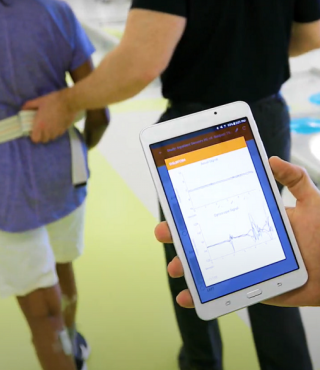Bibliography
Bernat, M.B., Parisi, S.B., Sebastian, E.N., Moscardo, L.D., Campos, J.F., Bueno, L.L. (2015). Determining cut-off points in functional assessment scales in stroke. Neurorehabilitation, (37), 165-172. Doi: 10.3233/NRE-151249
Bouwstra, H., Smit, E.B., Wattel, E.M., Van der Wouden, J.C., Hertogh, C.M.P.M., Terluin, B., & Terwee, C.B. (2018). Measurement properties of the barthel index in geriatric rehabilitation. Journal of the American Medical Directors Association, 20(4), 420-425.
Castiglia, S. F., Galeoto, G., Lauta, A., Palumbo, A., Tirinelli, F., Viselli, F., Santilli, V ., & Sacchetti, M. L. (2017). The culturally adapted italian version of the barthel index (IcaBI): Assessment of structural validity, inter-rater reliability and responsiveness to clinically relevant improvements in patients admitted to inpatient rehabilitation centers. Functional Neurology, 32(4), 221–227. doi:10.11138/fneur/2017.32.4.221
Collin, C., Wade, D. T., et al. (1988). "The Barthel ADL Index: a reliability study." International Disability Studies 10(2): 61-63. Find it on PubMed
de Morton, N. A., Keating, J. L., et al. (2008). "Rasch analysis of the barthel index in the assessment of hospitalized older patients after admission for an acute medical condition." Archives of Physical Medicine and Rehabilitation 89(4): 641-647. Find it on PubMed
Duffy, L., Gajree, S., Langhorne, P., Stott, D.J., & Quinn, T.J. (2013). Reliability (inter-rater agreement) of the barthel index for assessment of stroke survivors. American Heart Association, 462-468. Doi: 10.1161/STROKEAHA.112.678615
Duncan, P. W., Samsa, G. P., et al. (1997). "Health status of individuals with mild stroke." Stroke 28(4): 740-745. Find it on PubMed
Ellul, J., Watkins, C., et al. (1998). "Estimating total Barthel scores from just three items: the European Stroke Database 'minimum dataset' for assessing functional status at discharge from hospital." Age and Ageing 27(2): 115-122. Find it on PubMed
Galeoto, G., Formica, M. C., Mercuri, N. B., Santilli, V., Berardi, A., Castiglia, S. F., Mollica, R., & Servadio, A. (2019). Evaluation of the psychometric properties of the barthel index in an italian ischemic stroke population in the acute phase: A cross-sectional study. Functional Neurology, 34(1), 29-34.
Ghandehari, K., Ghandehari, K., Saffarian-Toosi, G., Masoudinezhad, S., Yazdani, S., Nooraddin, A., Ebrahimzadeh, S., Ahmadi, F., & Abrishamchi, F. (2012). Comparative interrater reliability of asian stroke disability scale, modified rankin scale and barthel index in patients with brain infarction. ARYA atherosclerosis, 8(3), 153–157.
Gonzalez, N., Bilbao, A., Forjaz, M.J., Ayala, A., Orive, M., Garcia-Gutierrez, S., Las Hayas, C., & Quintana, J.M. (2018). Psychometric characteristics of the spanish version of the barthel index. Aging Clinical and Experimental Research, 30(5), 489-497. Doi: 10.1007/s40520-017-0809-5
Granger, C. V., Albrecht, G. L., et al. (1979). "Outcome of comprehensive medical rehabilitation: measurement by PULSES profile and the Barthel Index." Archives of Physical Medicine and Rehabilitation 60(4): 145-154. Find it on PubMed
Green J, Forster A, Young J. A test-retest reliability study of the Barthel Index, the Rivermead Mobility Index, the Nottingham Extended Activities of Daily Living Scale and the Frenchay Activities Index in stroke patients. Disabil Rehabil. 2001;23(15):670‐676. doi:10.1080/09638280110045382
Grauwmeijer, E., Heijenbrok-Kal, M. H., et al. (2012). "A prospective study on employment outcome 3 years after moderate to severe traumatic brain injury." Arch Phys Med Rehabil 93(6): 993-999. Find it on PubMed
Gupta, A. and Taly, A. B. (2012). "Functional outcome following rehabilitation in chronic severe traumatic brain injury patients: A prospective study." Ann Indian Acad Neurol 15(2): 120-124. Find it on PubMed
Hobart, J. C. and Thompson, A. J. (2001). "The five item Barthel index." Journal of Neurology, Neurosurgery and Psychiatry 71(2): 225-230. Find it on PubMed
Hofstad, H., Naess, H., et al. (2012). "Early supported discharge after stroke in Bergen (ESD Stroke Bergen): a randomized controlled trial comparing rehabilitation in a day unit or in the patients' homes with conventional treatment." Int J Stroke. Find it on PubMed
Hormozi, S., Alizadeh-Khoei, M., Sharifi, F., Taati, F., Aminalroaya, R., Fadaee, S., Angooti-Oshnari, L., & Saghebi, H. (2019). Iranian version of the barthel index: Validity and reliability in outpatients’ elderly. International Journal of Preventative Medicine, 10(130), 1-5. DOI: 10.4103/ijpvm.IJPVM_579_18
Houlden, H., Edwards, M., et al. (2006). "Use of the Barthel Index and the Functional Independence Measure during early inpatient rehabilitation after single incident brain injury." Clinical rehabilitation 20(2): 153-159.
Hsieh, Y. W., Wang, C. H., et al. (2007). "Establishing the minimal clinically important difference of the Barthel Index in stroke patients." Neurorehabil Neural Repair 21(3): 233-238. Find it on PubMed
Hsueh, I. P., Lee, M. M., et al. (2001). "Psychometric characteristics of the Barthel activities of daily living index in stroke patients." J Formos Med Assoc 100(8): 526-532. Find it on PubMed
Hsueh, I. P., Lin, J. H., et al. (2002). "Comparison of the psychometric characteristics of the functional independence measure, 5 item Barthel index, and 10 item Barthel index in patients with stroke." Journal of Neurology, Neurosurgery and Psychiatry 73(2): 188-190. Find it on PubMed
Kwakkel, G., Veerbeek, J. M., Harmeling-van der Wel, B. C., van Wegan, E., & Kollen, B. J. (2011). Diagnostic accuracy of the barthel index for measuring activities or daily living outcome after ischemic hemispheric stroke. American Heart Association Journals, 42(2), 342-346. DOI: 10.1161/STROKEAHA.110.599035
Lin, J. H., Hsu, M. J., et al. (2010). "Psychometric comparisons of 3 functional ambulation measures for patients with stroke." Stroke 41(9): 2021-2025. Find it on PubMed
Lin, J. H., Hsu, M. J., et al. (2009). "Psychometric comparisons of 4 measures for assessing upper-extremity function in people with stroke." Physical Therapy 89(8): 840-850. Find it on PubMed
Liu, C., McNeil, J. E., et al. (2004). "Rehabilitation outcomes after brain injury: disability measures or goal achievement?" Clin Rehabil 18(4): 398-404. Find it on PubMed
Mayoral, A., Ibarz, E., Gracia, L., Mateo, J., & Herrera, A. (2019). The use of barthel index for the assessment of the functional recovery after osteoporotic hip fracture: One-year follow-up. PLOS One, 14(2), e021200. doi: 10.1371/journal.pone.0212000
McPherson, K. and Pentland, B. (1997). "Disability in patients following traumatic brain injury-which measure?" International Journal of Rehabilitation Research 20(1): 1-10.
Richards, S. H., Peters, T. J., et al. (2000). "Inter-rater reliability of the Barthel ADL index: how does a researcher compare to a nurse?" Clinical Rehabilitation 14(1): 72-78. Find it on PubMed
Rollnik, J. D. (2011). "The Early Rehabilitation Barthel Index (ERBI)." Rehabilitation (Stuttg) 50(6): 408-411. Find it on PubMed
Saito, T., Izawa, K., Matsui, N., Arai, K., Ando, M., Morimoto, K., Fujita, N., Takahashi, Y., Kawazoe, M., and Watanabe, S. (2016). Comparison of the measurement properties of the functional independence and difficulty scale with the barthel index in community-dwelling elderly people in japan. Aging Clinical and Experimental Research, 29, 273-281. doi: 10.1007/s40520-016-0558-x
Salbach, N. M., Mayo, N. E., et al. (2001). "Responsiveness and predictability of gait speed and other disability measures in acute stroke." Archives of Physical Medicine and Rehabilitation 82(9): 1204-1212. Find it on PubMed
Taghizadeh, G., Martinez-Martin, P., Meimandi, M., Habibi, S.A.H., Jamali, S., Dehmiyani, A., Rostami, S., Mahmuodi, A., Mehdizadeh, M., & Fereshtehnejad, S.M. (2019). Barthel index and modified rankin scale: Psychometric properties during medication phases in idiopathic parkinson disease. Annals of Physical and Rehabilitative Medicine, 1-5.
Tilling, K., Sterne, J. A., et al. (2001). "A new method for predicting recovery after stroke." Stroke 32(12): 2867-2873. Find it on PubMed
Unnanuntana, A., Jarusriwanna, A., and Nepal, S. (2018). Validity and responsiveness of barthel index for measuring functional recovery after hemiarthroplasty for femoral neck fracture. Archives of Orthopaedic and Trauma Surgery, 138, 1671-1677. doi: 10.1007/s00402-018-3020-z
Uyttenboogaart, M., Stewart, R. E., et al. (2005). "Optimizing cutoff scores for the Barthel index and the modified Rankin scale for defining outcome in acute stroke trials." Stroke 36(9): 1984-1987. Find it on PubMed
van Hartingsveld, F., Lucas, C., et al. (2006). "Improved interpretation of stroke trial results using empirical Barthel item weights." Stroke 37(1): 162-166. Find it on PubMed
Wade, D. T. and Hewer, R. L. (1987). "Functional abilities after stroke: measurement, natural history and prognosis." Journal of Neurology, Neurosurgery and Psychiatry 50(2): 177-182. Find it on PubMed
Wales, K., Lannin, N.A., Clemson, L., & Cameron, I.D. (2018). Measuring functional ability in hospitalized older adults: A validation study. Disability and Rehabilitation, 40(16), 1972-1978.


